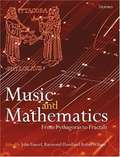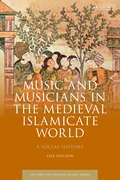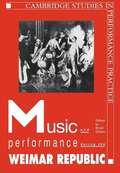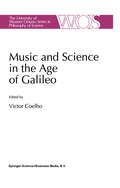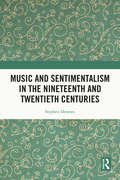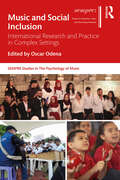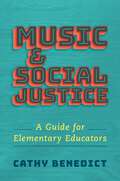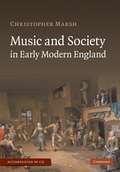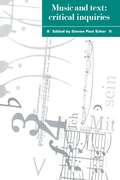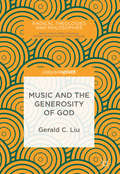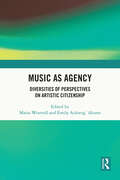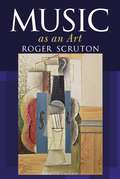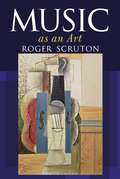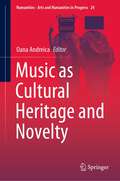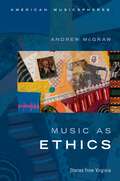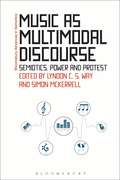- Table View
- List View
Music and Joy: Lessons on the Good Life
by Daniel K. ChuaFrom Confucius to Saint Augustine and Beethoven to the blues, a rediscovery of the joy that is music In this revelatory book, Daniel K. L. Chua asks a simple question: Is music joy? For Chua, the answer is a resounding yes—music is a lesson in joy that teaches us how to live well. But to hear this ancient knowledge, he says, we have to attend to a music that is so much greater than our greatest hits. Drawing on extensive sources, from the Confucian classics to the writings of Saint Augustine, Chua’s book is a globe‑trotting, time‑traveling, mind‑boggling journey to rediscover the joy that is music. Using examples from Beethoven to the blues and from philosophy and theology to music theory, Chua updates the relation between music and joy and argues for its relevance in the face of our many political and environmental crises. He opens our ears to a music that is the very definition of joy for today’s troubled world.
Music And Mathematics: From Pythagoras To Fractals (PDF)
by John Fauvel Raymond Flood Robin WilsonFrom Ancient Greek times, music has been seen as a mathematical art, and the relationship between mathematics and music has fascinated generations. This collection of wide ranging, comprehensive and fully-illustrated papers, authorized by leading scholars, presents the link between these two subjects in a lucid manner that is suitable for students of both subjects, as well as the general reader with an interest in music. Physical, theoretical, physiological, acoustic, compositional and analytical relationships between mathematics and music are unfolded and explored with focus on tuning and temperament, the mathematics of sound, bell-ringing and modern compositional techniques.
Music and Musicians in the Medieval Islamicate World: A Social History (Early and Medieval Islamic World)
by Lisa NielsonDuring the early medieval Islamicate period (800–1400 CE), discourses concerned with music and musicians were wide-ranging and contentious, and expressed in works on music theory and philosophy as well as literature and poetry. But in spite of attempts by influential scholars and political leaders to limit or control musical expression, music and sound permeated all layers of the social structure. Lisa Nielson here presents a rich social history of music, musicianship and the role of musicians in the early Islamicate era. Focusing primarily on Damascus, Baghdad and Jerusalem, Lisa Nielson draws on a wide variety of textual sources written for and about musicians and their professional/private environments – including chronicles, literary sources, memoirs and musical treatises – as well as the disciplinary approaches of musicology to offer insights into musical performances and the lives of musicians. In the process, the book sheds light onto the dynamics of medieval Islamicate courts, as well as how slavery, gender, status and religion intersected with music in courtly life. It will appeal to scholars of the Islamicate world and historical musicologists.
Music and Musicians in the Medieval Islamicate World: A Social History (Early and Medieval Islamic World)
by Lisa NielsonDuring the early medieval Islamicate period (800–1400 CE), discourses concerned with music and musicians were wide-ranging and contentious, and expressed in works on music theory and philosophy as well as literature and poetry. But in spite of attempts by influential scholars and political leaders to limit or control musical expression, music and sound permeated all layers of the social structure. Lisa Nielson here presents a rich social history of music, musicianship and the role of musicians in the early Islamicate era. Focusing primarily on Damascus, Baghdad and Jerusalem, Lisa Nielson draws on a wide variety of textual sources written for and about musicians and their professional/private environments – including chronicles, literary sources, memoirs and musical treatises – as well as the disciplinary approaches of musicology to offer insights into musical performances and the lives of musicians. In the process, the book sheds light onto the dynamics of medieval Islamicate courts, as well as how slavery, gender, status and religion intersected with music in courtly life. It will appeal to scholars of the Islamicate world and historical musicologists.
Music And Performance During The Weimar Republic: (pdf) (Cambridge Studies In Performance Practice Ser. #Series Number 3)
by Bryan Randolph GilliamFollowing the collapse of the Wilhelmine Empire in Germany, a new generation of artists found a fresh environment where they might flourish. Their optimism was accompanied by an equally powerful distrust of the immediate past, for post-romanticism - and ultimately expressionism - served as symbols of a bygone era. Composers, performers, and audiences alike sought to negate their recent past in various ways: by affirming modern technology (electronic or mechanical music, sound recordings, radio, and film), exploring music of a more remote past (principally Baroque music), and celebrating popular music (particularly jazz). The essays contained in this volume address these fundamental themes. Examining the way in which German music was performed, staged, programmed, and received in the 1920s, they not only offer deeper insights into Weimar culture itself but shed light on our contemporary musical world.
Music and Science in the Age of Galileo (The Western Ontario Series in Philosophy of Science #51)
by VictorCoelhoMusic and Science in the Age of Galileo features twelve new essays by leading specialists in the fields of musicology, history of science, astronomy, philosophy, and instrument building that explore the relations between music and the scientific culture of Galileo's time. The essays take a broad historical approach towards understanding such topics as the role of music in Galileo's experiments and in the scientific revolution, the musical formation of scientists, Galileo's impact on the art and music of his time, the scientific knowledge of instrument builders, and the scientific experiments and cultural context of Galileo's father, Vincenzo Galilei. This volume opens up new areas in both musicology and the history of science, and twists together various strands of parallel work by musicians and scientists on Galileo and his time. This book will be of interest to musicologists, historians of science and those interested in interdisciplinary perspectives of the late Renaissance -- early Baroque. For its variety of approaches, it will be a valuable collection of readings for graduate students, and those seeking a more integrated approach to historical problems. The book will be of interest to historians of science, philosophers, musicologists, astronomers, and mathematicians.
Music and Sentimentalism in the Nineteenth and Twentieth Centuries
by Stephen DownesIn a wide-ranging study of sentimentalism’s significance for styles, practices and meanings of music in the nineteenth and twentieth centuries, a series of interpretations scrutinizes musical expressions of sympathetic responses to suffering and the longing to belong. The book challenges hierarchies of artistic value and the associated denigration of sentimental feeling in gendered discourses. Fresh insights are thereby developed into sentimentalism’s place in musical constructions of emotion, taste, genre, gender, desire, and authenticity. The contexts encompass diverse musical communities, performing spaces, and listening practices, including the nineteenth-century salon and concert hall, the cinema, the intimate stage persona of the singer-songwriter, and the homely ambiguities of ‘easy’ listening. Interdisciplinary insights inform discussions of musical form, affect, appropriation, nationalisms, psychologies, eco-sentimentalism, humanitarianism, consumerism, and subject positions, with a particular emphasis on masculine sentimentalities. Music is drawn from violin repertory associated with Joseph Joachim, the piano music of Chopin, Schumann, and Liszt, sentimental waltzes from Schubert to Ravel, concert music by Bartók, Szymanowski and Górecki, the Merchant-Ivory adaptation of The Remains of the Day, Antônio Carlos Jobim’s bossa nova, and songs by Duke Ellington, Burt Bacharach, Carole King, Barry Manilow and Jimmy Webb. The book will attract readers interested in both the role of music in the history of emotion and the persistence and diversity of sentimental arts after their flowering in the eighteenth-century age of sensibility.
Music and Sentimentalism in the Nineteenth and Twentieth Centuries
by Stephen DownesIn a wide-ranging study of sentimentalism’s significance for styles, practices and meanings of music in the nineteenth and twentieth centuries, a series of interpretations scrutinizes musical expressions of sympathetic responses to suffering and the longing to belong. The book challenges hierarchies of artistic value and the associated denigration of sentimental feeling in gendered discourses. Fresh insights are thereby developed into sentimentalism’s place in musical constructions of emotion, taste, genre, gender, desire, and authenticity. The contexts encompass diverse musical communities, performing spaces, and listening practices, including the nineteenth-century salon and concert hall, the cinema, the intimate stage persona of the singer-songwriter, and the homely ambiguities of ‘easy’ listening. Interdisciplinary insights inform discussions of musical form, affect, appropriation, nationalisms, psychologies, eco-sentimentalism, humanitarianism, consumerism, and subject positions, with a particular emphasis on masculine sentimentalities. Music is drawn from violin repertory associated with Joseph Joachim, the piano music of Chopin, Schumann, and Liszt, sentimental waltzes from Schubert to Ravel, concert music by Bartók, Szymanowski and Górecki, the Merchant-Ivory adaptation of The Remains of the Day, Antônio Carlos Jobim’s bossa nova, and songs by Duke Ellington, Burt Bacharach, Carole King, Barry Manilow and Jimmy Webb. The book will attract readers interested in both the role of music in the history of emotion and the persistence and diversity of sentimental arts after their flowering in the eighteenth-century age of sensibility.
Music and Social Inclusion: International Research and Practice in Complex Settings (SEMPRE Studies in The Psychology of Music)
by Oscar OdenaHow do we develop social inclusion through musical activities? What is the power of music in enhancing individual inclusion, group cohesion, and cross-community work in post-conflict environments? How can we investigate social music programmes and interventions? This comprehensive volume offers new research on these questions by an international team of experts from the fields of music education, music psychology, ethnomusicology, and community music. The book celebrates the rich diversity of ways in which learners of all ages participate in social music projects in complex settings. Contributions focus broadly on musical and social processes, considering its conceptualisation and practices in a number of contexts. The authors examine how social music projects can be fostered in complex settings, drawing examples from schools and community settings. These critical chapters will inspire readers to think deeply about social music interventions and their development. The book will be of crucial interest to educators, policymakers, researchers, and students, as it draws on applied research from across 14 countries, of which ten are in the Global South.
Music and Social Inclusion: International Research and Practice in Complex Settings (SEMPRE Studies in The Psychology of Music)
by Oscar OdenaHow do we develop social inclusion through musical activities? What is the power of music in enhancing individual inclusion, group cohesion, and cross-community work in post-conflict environments? How can we investigate social music programmes and interventions? This comprehensive volume offers new research on these questions by an international team of experts from the fields of music education, music psychology, ethnomusicology, and community music. The book celebrates the rich diversity of ways in which learners of all ages participate in social music projects in complex settings. Contributions focus broadly on musical and social processes, considering its conceptualisation and practices in a number of contexts. The authors examine how social music projects can be fostered in complex settings, drawing examples from schools and community settings. These critical chapters will inspire readers to think deeply about social music interventions and their development. The book will be of crucial interest to educators, policymakers, researchers, and students, as it draws on applied research from across 14 countries, of which ten are in the Global South.
Music and Social Justice: A Guide for Elementary Educators
by Cathy BenedictIn this book author Cathy Benedict challenges and reframes traditional ways of addressing many of the topics we have come to think of as social justice. Offering practical suggestions for helping both teachers and students think philosophically (and thus critically) about the world around them, each chapter engages with important themes through music making and learning as it presents scenarios, examples of dialogue with students, unit ideas and lesson plans geared toward elementary students (ages 6-14). Taken-for-granted subjects often considered beyond the understanding of elementary students such as friendship, racism, poverty, religion, and class are addressed and interrogated in such a way that honours the voice and critical thinking of the elementary student. Suggestions are given that help both teachers and students to pause, reflect and redirect dialogue with questions that uncover bias, misinformation and misunderstandings that too often stand in the way of coming to know and embracing difference. Guiding questions, which anchor many curricular mandates, are used throughout in order to scaffold critical and reflective thinking beginning in the earliest grades of elementary music education. Where does social justice reside? Whose voice is being heard and whose is being silenced? How do we come to think of and construct poverty? How is it that musics become used the way they are used? What happens to songs initially intended for socially driven purposes when their significance is undermined? These questions and more are explored encouraging music teachers to embrace a path toward socially just engagements at the elementary and middle school levels.
Music And Society In Early Modern England (PDF)
by Christopher MarshMusic and Society in Early Modern England is the first comprehensive survey of English popular music during the early modern period to be published in over one hundred and fifty years. Christopher Marsh offers a fascinating and broad-ranging account of musicians, the power of music, broadside ballads, dancing, psalm-singing and bell-ringing. Drawing on sources ranging from ballads, plays, musical manuscripts and diaries to wills, inventories, speeches and court records, he investigates the part played by music in the negotiation of social relations, revealing its capacity both to unify and to divide. The book is lavishly illustrated and is accompanied by a website featuring forty-eight specially commissioned recordings by the critically acclaimed Dufay Collective. These include the first ever attempts to reconstruct the distinctively early-modern sounds of 'rough music' and unaccompanied congregational psalm-singing.
Music And Text: Critical Inquiries (PDF)
by Steven Paul ScherMelopoetics, the study of the multifarious relations between music and literature, has emerged in recent years as an increasingly popular field of interdisciplinary inquiry. In this volume, noted musicologists and literary critics explore diverse topics of shared concern such as literary theory as a model for musical criticism, genre theories in literature and music, the criticism and analysis of texted music and the role of aesthetic, historical and cultural understanding in concepts of text/music convergence. These fourteen essays - united here not by a common ideology but by common subject matter - demonstrate how musical and literary scholarship can combine forces effectively on the common ground of contemporary critical theory and interpretive practice. The concluding essay by interdisciplinary historian Hayden White locates this ambitious enterprise of contemplating 'music and text' in the larger context of intellectual history.
Music and the Emotions: The Philosophical Theories (International Library of Philosophy)
by Malcolm BuddIt has often been claimed, and frequently denied, that music derives some or all of its artistic value from the relation in which it stands to the emotions. This book presents and subjects to critical examination the chief theories about the relationship between the art of music and the emotions.
Music and the Emotions: The Philosophical Theories (International Library of Philosophy)
by Malcolm BuddIt has often been claimed, and frequently denied, that music derives some or all of its artistic value from the relation in which it stands to the emotions. This book presents and subjects to critical examination the chief theories about the relationship between the art of music and the emotions.
Music and the Generosity of God
by Gerald C. LiuWhat if sounds everywhere lavish divine generosity? Merging insights from Jean-Luc Marion with musical ingenuity from Pierre Boulez and John Cage’s 4’33”, Gerald C. Liu blends the phenomenological, theological, and musical to formulate a hypothesis that in all places, soundscapes instantiate divine giving without boundary. He aims to widen apprehension of holiness in the world, and privileges the ubiquity of sound as a limitless and easily accessible portal for discovering the inexhaustible magnitude of divine giving.
Music and the Generosity of God
by Gerald C. LiuWhat if sounds everywhere lavish divine generosity? Merging insights from Jean-Luc Marion with musical ingenuity from Pierre Boulez and John Cage’s 4’33”, Gerald C. Liu blends the phenomenological, theological, and musical to formulate a hypothesis that in all places, soundscapes instantiate divine giving without boundary. He aims to widen apprehension of holiness in the world, and privileges the ubiquity of sound as a limitless and easily accessible portal for discovering the inexhaustible magnitude of divine giving.
Music as Agency: Diversities of Perspectives on Artistic Citizenship
by Maria Westvall Emily Achieng’ AkunoMusic as Agency: Diversities of Perspectives on Artistic Citizenship focuses on the concept, application, interpretation and manifestation of Artistic Citizenship in diverse contexts. The key concepts that the book tackles are: Cultural experience, artistic practice, musical identities, equity, democracy, community, activism, resistance and empathy.In giving an overview of aspects of the compound concept of artistic citizenship, Akuno and Westvall present the outcome of research and interrogation of practice by a global network of educator-researchers from Africa, the Americas, Asia and Europe. The book articulates notions of artistic citizenship, coming up with the term artizenship as a derivative of the composite term. It further explains and analyses practical ways of perceiving and relating to art spaces, art practices and arts objects towards belonging, being and becoming in a global space that is disparate, polarised and often alienating, and thus responding to issues such as social justice, identity, participation and inclusion. With a focus on music, the book targets musicians, scholars, educators and enthusiasts keen on gaining a deeper understanding of how music and musicking can influence human interactions towards social integration, trust, cultural awareness and intercultural understanding.
Music as Agency: Diversities of Perspectives on Artistic Citizenship
Music as Agency: Diversities of Perspectives on Artistic Citizenship focuses on the concept, application, interpretation and manifestation of Artistic Citizenship in diverse contexts. The key concepts that the book tackles are: Cultural experience, artistic practice, musical identities, equity, democracy, community, activism, resistance and empathy.In giving an overview of aspects of the compound concept of artistic citizenship, Akuno and Westvall present the outcome of research and interrogation of practice by a global network of educator-researchers from Africa, the Americas, Asia and Europe. The book articulates notions of artistic citizenship, coming up with the term artizenship as a derivative of the composite term. It further explains and analyses practical ways of perceiving and relating to art spaces, art practices and arts objects towards belonging, being and becoming in a global space that is disparate, polarised and often alienating, and thus responding to issues such as social justice, identity, participation and inclusion. With a focus on music, the book targets musicians, scholars, educators and enthusiasts keen on gaining a deeper understanding of how music and musicking can influence human interactions towards social integration, trust, cultural awareness and intercultural understanding.
Music as an Art
by Roger ScrutonMusic as an Art begins by examining music through a philosophical lens, engaging in discussions about tonality, music and the moral life, music and cognitive science and German idealism, as well as recalling the author's struggle to encourage his students to distinguish the qualities of good music. Scruton then explains – via erudite chapters on Schubert, Britten, Rameau, opera and film – how we can develop greater judgement in music, recognising both good taste and bad, establishing musical values, as well as musical pleasures.As Scruton argues in this book, in earlier times, our musical culture had secure foundations in the church, the concert hall and the home; in the ceremonies and celebrations of ordinary life, religion and manners. Yet we no longer live in that world. Fewer people now play instruments and music is, for many, a form of largely solitary enjoyment. As he shows in Music as an Art, we live at a critical time for classical music, and this book is an important contribution to the debate, of which we stand in need, concerning the place of music in Western civilization.
Music as an Art
by Sir Roger ScrutonMusic as an Art begins by examining music through a philosophical lens, engaging in discussions about tonality, music and the moral life, music and cognitive science and German idealism, as well as recalling the author's struggle to encourage his students to distinguish the qualities of good music. Scruton then explains – via erudite chapters on Schubert, Britten, Rameau, opera and film – how we can develop greater judgement in music, recognising both good taste and bad, establishing musical values, as well as musical pleasures.As Scruton argues in this book, in earlier times, our musical culture had secure foundations in the church, the concert hall and the home; in the ceremonies and celebrations of ordinary life, religion and manners. Yet we no longer live in that world. Fewer people now play instruments and music is, for many, a form of largely solitary enjoyment. As he shows in Music as an Art, we live at a critical time for classical music, and this book is an important contribution to the debate, of which we stand in need, concerning the place of music in Western civilization.
Music as Cultural Heritage and Novelty (Numanities - Arts and Humanities in Progress #24)
by Oana AndreicaThis book provides a multifaceted view on the relation between the old and the new in music, between tradition and innovation. This is a much-debated issue, generating various ideas and theories, which rarely come to unanimous conclusions. Therefore, the book offers diverse perspectives on topics such as national identities, narrative strategies, the question of musical performance and musical meaning. Alongside themes of general interest, such as classical repertoire, the music of well-established composers and musical topics, the chapters of the book also touch on specific, but equally interesting subjects, like Brazilian traditions, Serbian and Romanian composers and the lullaby. While the book is mostly addressed to researchers, it can also be recommended to students in musicology, ethnomusicology, musical performance, and musical semiotics.
Music as Ethics: Stories from Virginia (AMERICAN MUSICSPHERES SERIES)
by Andrew McGrawMusic as Ethics offers a comparative ethnography of the relationship of music to ethics in four communities in Virginia, covering a wide range of demographic contexts and musical repertoires. Holy Cross Monastery in Berryville is a small community of fifteen Trappist monks who follow the rule of St. Benedict, composed in the early sixth century. Twin Oaks in Louisa is a ninety-member intentional community, founded in 1967, dedicated to egalitarianism. The "Sanctuary" in the Richmond city jail is a community of approximately forty residents drawn from two of the facility's dorms. Richmond is the state capital, with a fraught history of racial inequality. To say that we can experience music "as" ethics means that we can hold several, culturally informed attitudes about music's ethical meanings and functions. While music's relationship to ethical life differs between each community, the case studies suggest that we can all grow as ethical individuals and communities if we pay close attention to music's ethical potential. But as long as our experience of music as ethics remains implicit and vague, we miss an opportunity to fully realize its ethical affordances. More than that, we also expose ourselves to manipulation by those who would wield music (and other "affective" means) for their own social agenda.
Music as Ethics: Stories from Virginia (AMERICAN MUSICSPHERES SERIES)
by Andrew McGrawMusic as Ethics offers a comparative ethnography of the relationship of music to ethics in four communities in Virginia, covering a wide range of demographic contexts and musical repertoires. Holy Cross Monastery in Berryville is a small community of fifteen Trappist monks who follow the rule of St. Benedict, composed in the early sixth century. Twin Oaks in Louisa is a ninety-member intentional community, founded in 1967, dedicated to egalitarianism. The "Sanctuary" in the Richmond city jail is a community of approximately forty residents drawn from two of the facility's dorms. Richmond is the state capital, with a fraught history of racial inequality. To say that we can experience music "as" ethics means that we can hold several, culturally informed attitudes about music's ethical meanings and functions. While music's relationship to ethical life differs between each community, the case studies suggest that we can all grow as ethical individuals and communities if we pay close attention to music's ethical potential. But as long as our experience of music as ethics remains implicit and vague, we miss an opportunity to fully realize its ethical affordances. More than that, we also expose ourselves to manipulation by those who would wield music (and other "affective" means) for their own social agenda.
Music as Multimodal Discourse: Semiotics, Power and Protest (Bloomsbury Advances in Semiotics)
by Lyndon C. Way Simon McKerrellWe communicate multimodally. Everyday communication involves not only words, but gestures, images, videos, sounds and of course, music. Music has traditionally been viewed as a separate object that we can isolate, discuss, perform and listen to. However, much of music's power lies in its use as multimodal communication. It is not just lyrics which lend songs their meaning, but images and musical sounds as well. The music industry, governments and artists have always relied on posters, films and album covers to enhance music's semiotic meaning. Music as Multimodal Discourse: Semiotics, Power and Protest considers musical sound as multimodal communication, examining the interacting meaning potential of sonic aspects such as rhythm, instrumentation, pitch, tonality, melody and their interrelationships with text, image and other modes, drawing upon, and extending the conceptual territory of social semiotics. In so doing, this book brings together research from scholars to explore questions around how we communicate through musical discourse, and in the discourses of music. Methods in this collection are drawn from Critical Discourse Analysis, Social Semiotics and Music Studies to expose both the function and semiotic potential of the various modes used in songs and other musical texts. These analyses reveal how each mode works in various contexts from around the world often articulating counter-hegemonic and subversive discourses of identity and belonging.

